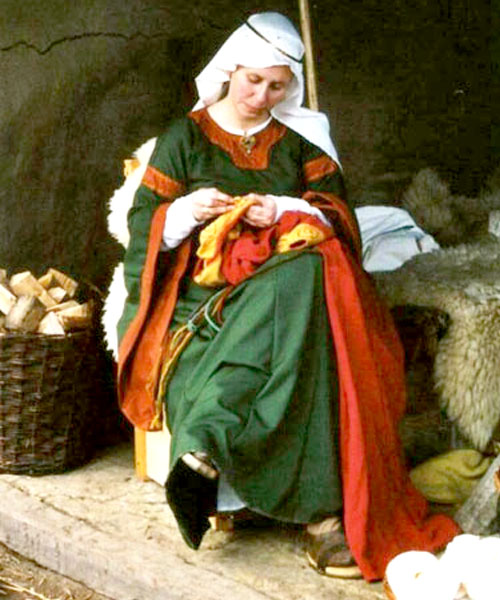
12th Century The Bliaut
Description
Bliaut in thin green and orange wool, I did not have enough
fabric to make the wrinkeled torso version, so I made the gored
skirt version.
The dress is embroidered with silk, all natural dyed, some by
myself some bought at a viking market.
Underneath the green/orange overdress a thin linen dress in the
same model as the wool overdress is worn, but without the
lacings and pendants sleeves. Instead the sleeves are cut tight
and longer than my arm to create wrinkels at the wrists.
The belt is strip of wool orange fabric, more that 2.30 long and
the wool cords that hang from it and woollen yarn sewn unto it
are all natural dyed by me, with dyes appropriate for the period.
The original bel
ts were probably wide tabletwoven bands, and as I am still
learning to tabletweave, I choose to mimic the look by applying
cords on a strip of fabric.
On my head I am wearing a silk oval veil with a circlet. The
braidcasings are made of the same fabric as my dress and are
pinned to my fillet, as my hair is not long to wear in braids or
to attach the braidcasings to.
For warmth we made a greenish/yellowish half circle cloak, it
closes in the front with (again) naturally dyed cords dyed by
myself.
All visible seems have been handsewn with silk thread.
Inspiration
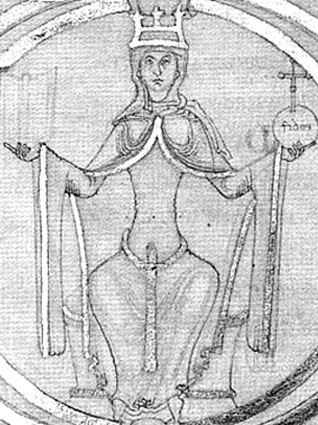
Image from the Great Bible of Winchester also know as the Winchester Psalter, ca.1160-70
Patterns used
No commercial pattern used.
More information
I based my construction of the dress on that of a 10-12th century islamic man's shirt from Egypt, that I found in Cut my Cote written by Dorothy Burnham and on the theory and the drawing of the original cut of the Bral of Don Garcia which can be found, somewhere, in the bliaut files written by Lady Marguerie de Jauncourt.
Please note that the sleeves starts to expand after the elbow, something which is not clear from my drawing. The embroidered band around the upper arm covers the seam.

Construction of a 10-12th century islamic man's shirt..
Source: Cut my Cote - Dorothy Burnham
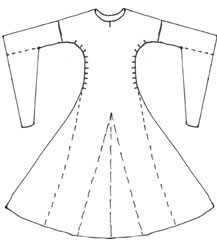
Drawing of the original cut of the Bral of Don Garcia.
Source: The Bliaut files written by Lady Marguerie de Jauncourt
Like most names costumers use to refer to a costume the term "bliaut" or
"bliaud" is heavily debated. So I tried to find out what the word originally
ment. I found a description of the term bliaut in the Glossary of Handbook of
English Mediaevil Costume by C Willet and P.Cunnington.
Bliaut french term for:
- Costly material
- A man's costume worn with armour or at court
- A lady's court dress
Maybe bliaut/bliaud is originally the name of the type of silk that the version imported from Israël were made of ? In my opinion we can all safely use the name bliaut as most people interested in medieval costuming will immediatley know about which costume we are talking. Or do they ? Some people call all dresses from the 12th century, or sometimes even the 11th century, with pendant sleeves a bliaut. So what excactly is the definition of a bliaut ?
Description of the 12th century court dress as found in:
- Handbook of English Mediaevil Costume by C Willet and P.Cunnington;
"...The new style (1130-1170), appearing after the first quarter, was characteristic of the twelfth century, but worn by ladies of rank only. The bodice was moulded after the figure, fitting tightly down to the hips; below that level the skirt, cut to expend considerably, fell in may close folds to the ground, often spreading behind into a train...
...The sleeves were tight fitting to below the elbows, where they abruptly expanded into lang hanging cuffs often reaching te ground and appearing like 'streamers' dependent from the wrist. Sometimes they were bulged out below forming pouches..."
-
History of Costume by Blanche Payne
"...The bliaut consisted of a closely fitted elongated bodice to which a very full skirt was sewn. The sleeves were excessively wide and long..."
In the 12th century there where several types of dresses, after reading the
descriptions of Cunnington and Payne, only two of them I consider to be real
bliauts.
The key features being:
- a tight bodice
- a wide skirt
- tight fitting sleeves to below the elbows, expanding into long hanging cuffs
- costume from the 12th century
Description of the two types.
The Bliaut with pleated torso and pleated on skirts, with tight sleeves widening from the forearm and a wide, tightly pleated on skirt. More width in the skirt panels may be added for extra fullness. May be laced at sides, or simply made very snug and pulled over the head. Can be made with keyhole or slit-v type neckline. In my opinion if you want to recreate this dress a closely as possible you need to use thin silk. As that is the only way to achieve the fine wrinkels in the torso and skirt of the dress.
The Bliaut with gored skirts, fashionable cut dress, with tight sleeves
belled from the elbow and a widely gored skirt. More gores may be added for
extra fullness. May be laced at sides, or simply made very snug and pulled over
the head. This is the version I made it can be made in thin wool or linen, as
there is still a lot of discussion about the use of (colored) linen for
outergarments, I prefer to use wool.
Some people believe that the bliaut was only worn in France and England, but it
was a fashion worn by noble ladies in a lot of European countries. Here are some
examples.
France
The best know bliaut versions are these on the statues of the Chartres Catherdral, France. Most of them are from the pleated bliaut type but I agree with Lady Lady Marguerie de Jauncourt from the bliaut files that the dress of Lady Underfoot could be a gored bliaut.
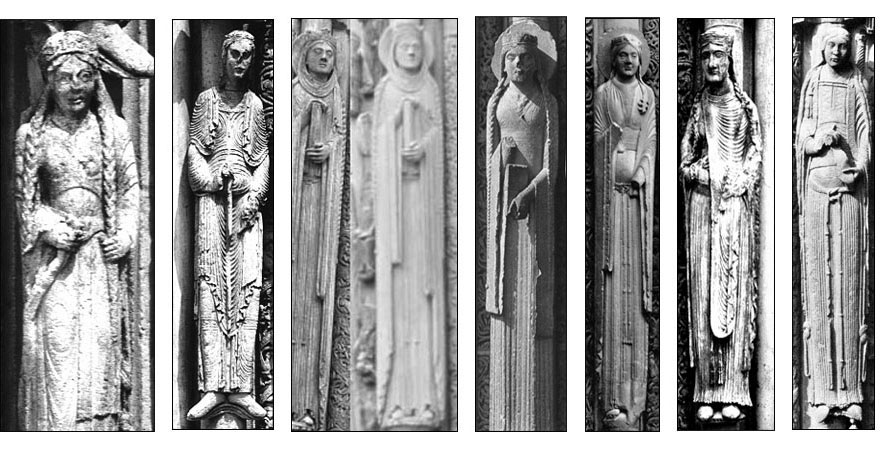
- "Lady Underfoot"
- "Lady with Embroidered Hem"
- "Queen Clasping Book"
- "Literary Queen"
- "Handless Queen" also know as "Queen of Juda"
- "Cloaked Lady"
- "Lady without crown"
Where the Charters statues mainly shows the pleated bliaut, The Hortus Deliciarum shows a larger diversity of 12th century dress styles including the pleated and gored bliaut.
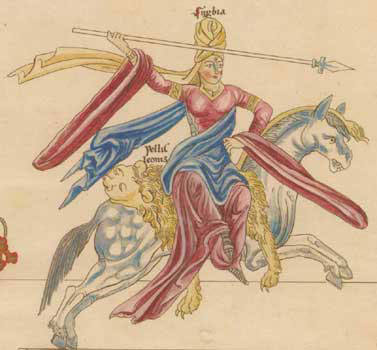
Source:Superbia, ca.1180, Hortus Deliciarum by Abbess Herrade de Landsburg (fl 1165-95.)

Source: The Lovers, ca.1180, Hortus Deliciarum by Abbess Herrade de Landsburg
(fl 1165-95.)
In these drawings from the
Hortus Deliciarum you can see the lacings at the side. The image of Superbia
also shows the band on the upper arm.


(l)Queen of Sheba from Notre Dame de Corbeil, source: History of Costume,
Blanche Payne
(r) Lady and the Knight from Chelles Reliquary ca. 1170
England
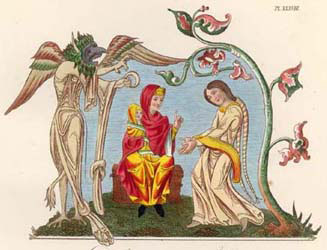
The image of the devil in laced gown (l), from the Winchester Psalter, redrawn by Strutt. Gives a hint about how the church vieuwed this tight and revealing fashion. It was common to tie the pendant sleeve in a knot as is visible in these images it keeps the long sleeves from dragging on the floor.
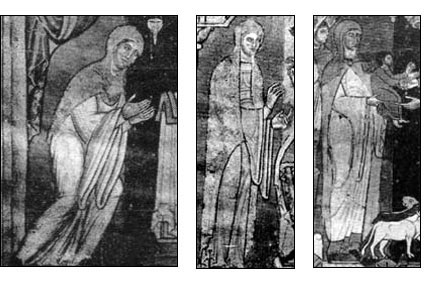
Details from scenes in the life of David and Samuel. From a folio Bible,
executed at St. Swithin's Priory, Winchester by the same artist that made the
Winchester Psalter and around the same time 1160-1170.
Spanish

(l)Detail of Chartulary of Oviedo 1126-1129, Queen Mummadonna.
(r) St.Julia and the Devil, from the third quarter of the 12th century.
Source:The book of costume, Milla Davenport
Swiss
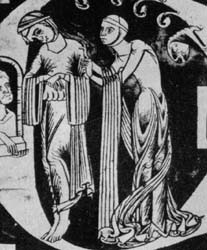
Engelberg Monastry Library, Codex 14,
source:The book of costume, Milla Davenport.
Sweden
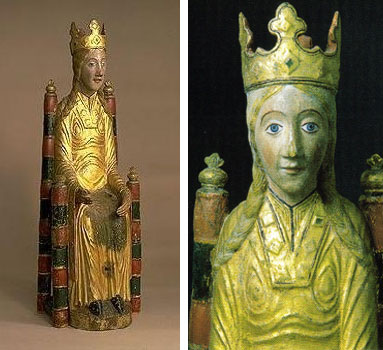
Madonna from Viklau Church,Sweden. Carved polychroom wood. The Museum of National Antiquities, Stockholm.
Alternate views
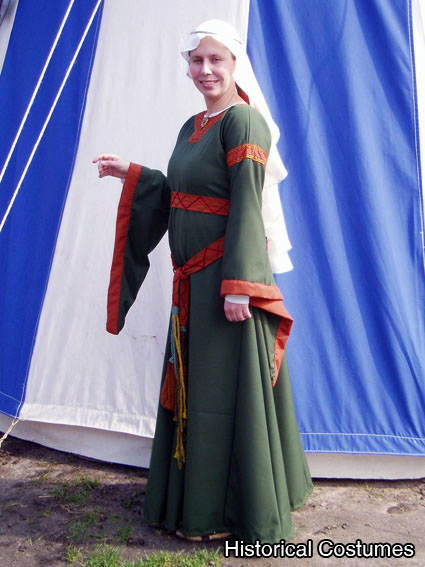
Less flattering picture but a better view of the gown and it's details.
Costume made and worn in 2006.



